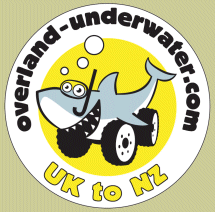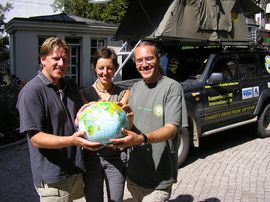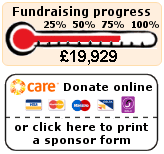| Final Statistics: Alex & Maz | Total distance: 93,550km |
| Furthest Point: Rotorua, NZ | Now settled in Sydney, Australia |
| Final Statistics: Martin | Total distance: 79,698km |
| Furthest Point: Hobart, Australia | Now settled in Bristol, UK |
Rebuilding lives after tsunami devastation
Thailand, Country 19, Diary entry 17-21st June 2006, Total distance in Thailand (first pass!): 4099 KM, (second pass!): 3005 KM, (Total): 7104 KM
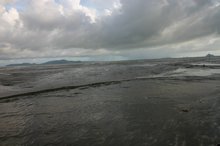 Thailand�s Andaman coast, was one of the coasts where the December 26, 2004 tsunami wreaked the most havoc. While the loss of life in Thailand was not comparable to some other South East Asian countries, the devastation was profound. Neither locals nor foreign tourists were spared in the disaster. In many cases, the death toll was higher among foreigners, since the tsunami struck during the tourist/holiday season. With official UN numbers, the death toll in Thailand stood at 8,212 with many more reported injuries, and many more displaced. Pang Nga province was hit the hardest, with almost 1,000 missing and over 5,000 injured. Migrant workers, especially those from Myanmar who were working on fishing boats or in related industries, proved to be the hardest to account for since many were undocumented migrants originally.
Thailand�s Andaman coast, was one of the coasts where the December 26, 2004 tsunami wreaked the most havoc. While the loss of life in Thailand was not comparable to some other South East Asian countries, the devastation was profound. Neither locals nor foreign tourists were spared in the disaster. In many cases, the death toll was higher among foreigners, since the tsunami struck during the tourist/holiday season. With official UN numbers, the death toll in Thailand stood at 8,212 with many more reported injuries, and many more displaced. Pang Nga province was hit the hardest, with almost 1,000 missing and over 5,000 injured. Migrant workers, especially those from Myanmar who were working on fishing boats or in related industries, proved to be the hardest to account for since many were undocumented migrants originally.
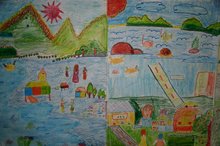 Raks Thai team, the local affiliate to CARE, have been working diligently in the hardest hit southern provinces of Pang Nga, Ranong and Krabi. After a period of initial emergency relief, including handing out medical supplies at three hospitals and setting up 145 temporary shelters for displaced Thais and the Moken community, Raks Thai proceeded with its rehabilitation programming. To date, Raks Thai Foundation has initiated community micro-credit programs in 50 villages providing 2,237 families with resources to generate income and to begin rebuilding their lives.
Raks Thai team, the local affiliate to CARE, have been working diligently in the hardest hit southern provinces of Pang Nga, Ranong and Krabi. After a period of initial emergency relief, including handing out medical supplies at three hospitals and setting up 145 temporary shelters for displaced Thais and the Moken community, Raks Thai proceeded with its rehabilitation programming. To date, Raks Thai Foundation has initiated community micro-credit programs in 50 villages providing 2,237 families with resources to generate income and to begin rebuilding their lives.
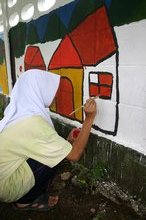 Anchalee Phonkling, a field co-ordinator for Raks Thai very kindly organised for Max, Alex and myself (unfortunately for Martin, he had a date in Malaysia to attend and therefore couldn�t make it) to have the chance to meet some of these revolving fund beneficiaries and to hear their stories. CARE/Raks Thai has also established youth activities programs for 300 youths in an affected area, set up six units of permanent housing, and initiated migrant worker assistance programming/collaboration with other NGOs.
Anchalee Phonkling, a field co-ordinator for Raks Thai very kindly organised for Max, Alex and myself (unfortunately for Martin, he had a date in Malaysia to attend and therefore couldn�t make it) to have the chance to meet some of these revolving fund beneficiaries and to hear their stories. CARE/Raks Thai has also established youth activities programs for 300 youths in an affected area, set up six units of permanent housing, and initiated migrant worker assistance programming/collaboration with other NGOs.
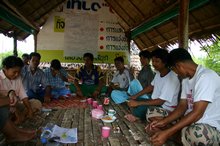 After returning from Koh Tao on the afternoon ferry, a long windy drive to Ranong where we found a great self service DIY steamboat where we ate as much as we could, we found a place to camp in front of the beach. After a night of howling rain, getting wet (Max more so in his little tent on the floor than us) and the fishermen rising before the sun making as much noise as possible, we rose a little exhausted. We drove to Bang Bane school where our first appointment was with Anchalee and the rest of the Raks Thai team. We were warmly greeted and immediately shown the breakfast stand where we helped ourselves to rice soup, deep fried dough (to obligatorily dump in the coffee) and boiled eggs.
After returning from Koh Tao on the afternoon ferry, a long windy drive to Ranong where we found a great self service DIY steamboat where we ate as much as we could, we found a place to camp in front of the beach. After a night of howling rain, getting wet (Max more so in his little tent on the floor than us) and the fishermen rising before the sun making as much noise as possible, we rose a little exhausted. We drove to Bang Bane school where our first appointment was with Anchalee and the rest of the Raks Thai team. We were warmly greeted and immediately shown the breakfast stand where we helped ourselves to rice soup, deep fried dough (to obligatorily dump in the coffee) and boiled eggs.
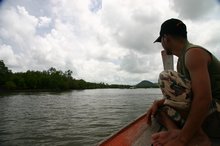 Bang Bane community centre, sponsored by Merck, had opened two days previous and we were in awe of the colourful pictures decorating the whole of the inside. Drawn by the children of the community, the big bits of paper hung around the room, displaying bright, colourful scenes of images and thoughts the children held for the future. Blue skies, waterfalls, green gardens, rebuilt houses, smiling faces. All a huge transformation from the grey, sad scenes they had depicted on the same exercise, a year previously. The next exercise for the children was to paint these colourful scenes onto the whitewashed wall surrounding the grounds to brighten it up. Max even had a go, but had to be supervised by an 8 year old to make sure he didn�t paint out of line! With the rain being indecisive, whether to stay or go the painting frenzy was intermingled with spouts of running to and from shelter to stay as dry as possible. We left them to doing an excellent job, while Anchalee talked to us about our itinerary for the upcoming 4 days we had with her.
Bang Bane community centre, sponsored by Merck, had opened two days previous and we were in awe of the colourful pictures decorating the whole of the inside. Drawn by the children of the community, the big bits of paper hung around the room, displaying bright, colourful scenes of images and thoughts the children held for the future. Blue skies, waterfalls, green gardens, rebuilt houses, smiling faces. All a huge transformation from the grey, sad scenes they had depicted on the same exercise, a year previously. The next exercise for the children was to paint these colourful scenes onto the whitewashed wall surrounding the grounds to brighten it up. Max even had a go, but had to be supervised by an 8 year old to make sure he didn�t paint out of line! With the rain being indecisive, whether to stay or go the painting frenzy was intermingled with spouts of running to and from shelter to stay as dry as possible. We left them to doing an excellent job, while Anchalee talked to us about our itinerary for the upcoming 4 days we had with her.
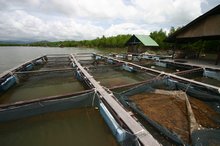 Our first stop was to meet with some fishermen who Raks Thai are working with to rehabilitate their lifestyles. We would be taken out fishing with them and shown first hand the farms and cages they were rebuilding. The next day would take us to stay with a family who were rebuilding their fishing business, but also extending their livelihood by learning about community-based tourism. We�d then move on to the most tsunami devastated area, take a look at the memorial site now standing there and visit the information centre detailing and picturing the atrocities of the disaster. Finally, we�d be visiting families who had extended their livelihood by joining an occupational group basket weaving and making Thai sweets. It was a full timetable and took us some hundreds of Kilometres down the south west peninsula of Thailand.
Our first stop was to meet with some fishermen who Raks Thai are working with to rehabilitate their lifestyles. We would be taken out fishing with them and shown first hand the farms and cages they were rebuilding. The next day would take us to stay with a family who were rebuilding their fishing business, but also extending their livelihood by learning about community-based tourism. We�d then move on to the most tsunami devastated area, take a look at the memorial site now standing there and visit the information centre detailing and picturing the atrocities of the disaster. Finally, we�d be visiting families who had extended their livelihood by joining an occupational group basket weaving and making Thai sweets. It was a full timetable and took us some hundreds of Kilometres down the south west peninsula of Thailand.
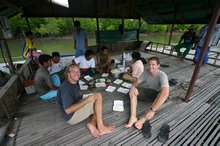 A revolving fund is a sum of money that is given to a community by Raks Thai for individuals to borrow so they can rebuild the businesses they once had or begin to build new ones - basically it is the same as us applying for a bank loan. If you want to use the revolving fund, you need to become a member of the group. Typically, there is a 17 person committee, chosen by the members, who make the decisions of who can borrow what money. The process is simple, application forms have to be completed, then submitted to the committee who decide whether the money is to be given. With these communities being mainly Muslim, interest is not allowed to be added to the loan, so instead, a one off �loan charge� is administrated and paid back with the first repayment. To make sure it�s all above board, transparency and democracy are the key principles adhered to and accountancy training is also given, along with audits to make sure the system works well.
A revolving fund is a sum of money that is given to a community by Raks Thai for individuals to borrow so they can rebuild the businesses they once had or begin to build new ones - basically it is the same as us applying for a bank loan. If you want to use the revolving fund, you need to become a member of the group. Typically, there is a 17 person committee, chosen by the members, who make the decisions of who can borrow what money. The process is simple, application forms have to be completed, then submitted to the committee who decide whether the money is to be given. With these communities being mainly Muslim, interest is not allowed to be added to the loan, so instead, a one off �loan charge� is administrated and paid back with the first repayment. To make sure it�s all above board, transparency and democracy are the key principles adhered to and accountancy training is also given, along with audits to make sure the system works well.
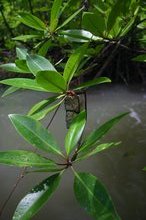 After discussing and rescheduling some of the details of the field trip as we had to leave the country by the 22nd June as our visas ran out, our first stop was with the fishermen. Met by 10 or so men, we heard of their stories and the way they were trying to rebuild their lives. The first thing that struck me as Anchalee was translating our conversation was the positiveness of their attitudes. Down but not out, with the help of the revolving fund they were slowly clambering their way back to how their lives once were.
After discussing and rescheduling some of the details of the field trip as we had to leave the country by the 22nd June as our visas ran out, our first stop was with the fishermen. Met by 10 or so men, we heard of their stories and the way they were trying to rebuild their lives. The first thing that struck me as Anchalee was translating our conversation was the positiveness of their attitudes. Down but not out, with the help of the revolving fund they were slowly clambering their way back to how their lives once were.
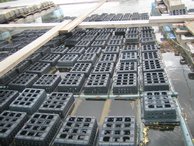 The main example for the fishermen, was the need to replace the fishing boats, crab cages and fish farms that were destroyed with the wave. After the initial disaster, many NGOs came to help provide shelter and help get the communities functioning again. Within a short space of time, only a few were left helping. More concerning, once the private sectors began giving aid, problems developed as nothing was controlled and was rationalised to us as �children bickering in the school yard� as the way they went about their business. Many boats and engines were given out, even to non fisherman, so there are now those who have changed careers with the aid of external funding. This was categorised as the second tsunami wave to hit the region. All told, a lot of help was given, and it is very much appreciated by those who have been helped.
The main example for the fishermen, was the need to replace the fishing boats, crab cages and fish farms that were destroyed with the wave. After the initial disaster, many NGOs came to help provide shelter and help get the communities functioning again. Within a short space of time, only a few were left helping. More concerning, once the private sectors began giving aid, problems developed as nothing was controlled and was rationalised to us as �children bickering in the school yard� as the way they went about their business. Many boats and engines were given out, even to non fisherman, so there are now those who have changed careers with the aid of external funding. This was categorised as the second tsunami wave to hit the region. All told, a lot of help was given, and it is very much appreciated by those who have been helped.
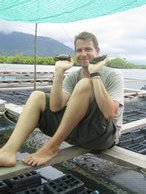 We were taken out on the boats to see the cages and farms first hand. Long narrow boats, hurled us through the mangrove swamps to visit the crab and fish farms floating in the open sections of the river. Large squares holes with a net fastened to each side, kept fish safely while growing to be sold. It was then time to hunt for the cages submerged beneath the water. Small cages with a hole just big enough for crabs to enter, but designed in a way for them not to get out. I collected all the cages laid down, finding a total of 15 small crabs to be farmed. At the farm they put the crab in a small box, submersed in the water to grow before being sold. Much of the fish is exported to Japan.
We were taken out on the boats to see the cages and farms first hand. Long narrow boats, hurled us through the mangrove swamps to visit the crab and fish farms floating in the open sections of the river. Large squares holes with a net fastened to each side, kept fish safely while growing to be sold. It was then time to hunt for the cages submerged beneath the water. Small cages with a hole just big enough for crabs to enter, but designed in a way for them not to get out. I collected all the cages laid down, finding a total of 15 small crabs to be farmed. At the farm they put the crab in a small box, submersed in the water to grow before being sold. Much of the fish is exported to Japan.
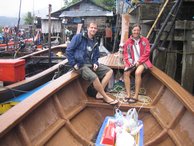 With our concerns for over fishing, now there seems to be many more fishermen than before the tsunami, we discussed them with the men. Crabs have to be a certain size before they are allowed to be farmed, as do the fish. This did not assure us of the decline in total numbers of fish that will occur if they all continue to fish the same waters, but at present the concern was to rebuild the damaged business. Meetings are held on a regular basis and concerns of the future brought up by the fishermen and Raks Thai are discussed and a need for conclusions debated. The fishermen are keen to start up an environmental club with the help of Raks Thai, to put a stop to dynamite fishing, the stealing of boats and engines and the poaching of the fish. Shelters have now been built on the farms and where the men keep their boats, so they can watch over them at night. A rota system between the community is organised and two men a night watch over the boats. Families share the task of watching over the farms.
With our concerns for over fishing, now there seems to be many more fishermen than before the tsunami, we discussed them with the men. Crabs have to be a certain size before they are allowed to be farmed, as do the fish. This did not assure us of the decline in total numbers of fish that will occur if they all continue to fish the same waters, but at present the concern was to rebuild the damaged business. Meetings are held on a regular basis and concerns of the future brought up by the fishermen and Raks Thai are discussed and a need for conclusions debated. The fishermen are keen to start up an environmental club with the help of Raks Thai, to put a stop to dynamite fishing, the stealing of boats and engines and the poaching of the fish. Shelters have now been built on the farms and where the men keep their boats, so they can watch over them at night. A rota system between the community is organised and two men a night watch over the boats. Families share the task of watching over the farms.
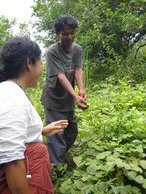 We were lucky enough to sample the fish and crab for dinner, and after returning from a respite at the office to catch up on a couple of things, we sampled the most divine dinner, possibly on the trip! Freshly barbequed fish, steamed crab from the farm, we ate and ate and ate until we had finally convinced them we could eat no more!
We were lucky enough to sample the fish and crab for dinner, and after returning from a respite at the office to catch up on a couple of things, we sampled the most divine dinner, possibly on the trip! Freshly barbequed fish, steamed crab from the farm, we ate and ate and ate until we had finally convinced them we could eat no more!
The following morning I rode with Anchalee as the boys followed and we drove south for a couple of hours to Baan Had Tray Pier where a 30 minute boat ride took us to Baan Thung Nang Dam. We had a 15 minute walk to our home stay where we were warmly greeted by the family who were providing our shelter for the night. A lone house on top of the island, with acres of land covered in palms and fruit trees.
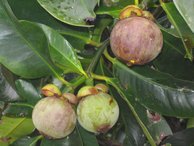 Once we were settled, we spoke with the family members about how Raks Thai are helping them. Once and still a fisherman, the head of the family told us that he used the revolving fund to help rebuild and improve his fish farm and buy fertilizer for his crop plantation. Having only set up the new fish farm 6 months previously, the fish were still breeding so the business was not as developed as before the disaster. The family were also branching out with another idea that Raks Thai are developing. So as not to 'put all their eggs in one basket' they were also beginning to involve themselves in community based tourism to improve their way of life, give homestays and tours of the island they live on. Rattiya & Somsak the two children still at home, went to class on the mainland twice a week to learn English and work with other families doing the same and learning more about tourism. Working alongside Raks Thai and NATR they begin to improve on their group building and get advice and encouragement.
Once we were settled, we spoke with the family members about how Raks Thai are helping them. Once and still a fisherman, the head of the family told us that he used the revolving fund to help rebuild and improve his fish farm and buy fertilizer for his crop plantation. Having only set up the new fish farm 6 months previously, the fish were still breeding so the business was not as developed as before the disaster. The family were also branching out with another idea that Raks Thai are developing. So as not to 'put all their eggs in one basket' they were also beginning to involve themselves in community based tourism to improve their way of life, give homestays and tours of the island they live on. Rattiya & Somsak the two children still at home, went to class on the mainland twice a week to learn English and work with other families doing the same and learning more about tourism. Working alongside Raks Thai and NATR they begin to improve on their group building and get advice and encouragement.
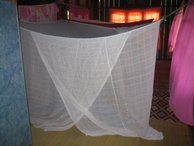 With the income still drifting in only occasionally as they build interest up, they still work on the land. They like the way of life and look forward to having more business which they feel will improve their well being. Rattiya liked receiving visitors and the cultural exchange of knowledge, something that will increase and grow with time. We were shown around the plantation by Somsak and tasted most of what they grew, the mangosteins going down a treat! We talked with different members of the family, mainly using Anchalee as translator. The rains then came in force and so we relaxed and played a game of Carcassone (it comes everywhere with us!) while Rattiya cooked dinner. Green chicken curry, rice, pad thai to name a few, we devoured our lot before returning to Carcassone for a final rundown. Had the rains stopped, we have seen more of the island, but with the constant downpour, we unfortunately missed out.
With the income still drifting in only occasionally as they build interest up, they still work on the land. They like the way of life and look forward to having more business which they feel will improve their well being. Rattiya liked receiving visitors and the cultural exchange of knowledge, something that will increase and grow with time. We were shown around the plantation by Somsak and tasted most of what they grew, the mangosteins going down a treat! We talked with different members of the family, mainly using Anchalee as translator. The rains then came in force and so we relaxed and played a game of Carcassone (it comes everywhere with us!) while Rattiya cooked dinner. Green chicken curry, rice, pad thai to name a few, we devoured our lot before returning to Carcassone for a final rundown. Had the rains stopped, we have seen more of the island, but with the constant downpour, we unfortunately missed out.
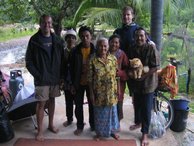 The next day, our journey continued south on the mainland past a police boat lodged between trees 2km inland, thrown there by the tsunami and left as a poignant reminder of the powerful force of Mother Nature. We then reached the memorial area. Before and after pictures were on display in the exhibition centre. It was amazing to see just how the topography has changed since the wave hit - much more land is now underwater than before. The memorial statue, a passage to walk down with a wall shaped into a wave witch has a boat built at the front, is a tasteful reminder of those nationalities lost. Plaques depicting all countries from those who lost their lives are mounted on the wall.
The next day, our journey continued south on the mainland past a police boat lodged between trees 2km inland, thrown there by the tsunami and left as a poignant reminder of the powerful force of Mother Nature. We then reached the memorial area. Before and after pictures were on display in the exhibition centre. It was amazing to see just how the topography has changed since the wave hit - much more land is now underwater than before. The memorial statue, a passage to walk down with a wall shaped into a wave witch has a boat built at the front, is a tasteful reminder of those nationalities lost. Plaques depicting all countries from those who lost their lives are mounted on the wall.
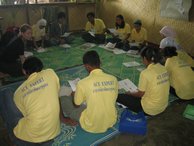 Our final homestay was at Khun Sa Mute, in the Koh Lanta district. We were the first visitors they had received in the village and so for the whole week before our arrival, had been preparing for us. Cleaning the house, cleaning the village, making sure everyone knew their role when we turned up. We felt we had been elevated to a much higher status than was reality, which was not what we wanted. However, they were so pleased to see us and felt privileged that we wanted and had made the effort to see their village and the work they did, that they felt justified in the preparation.
Our final homestay was at Khun Sa Mute, in the Koh Lanta district. We were the first visitors they had received in the village and so for the whole week before our arrival, had been preparing for us. Cleaning the house, cleaning the village, making sure everyone knew their role when we turned up. We felt we had been elevated to a much higher status than was reality, which was not what we wanted. However, they were so pleased to see us and felt privileged that we wanted and had made the effort to see their village and the work they did, that they felt justified in the preparation.
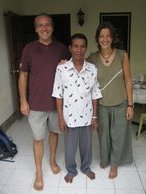 We arrived late and were provided dinner at Daeng�s house. When we were shown into the house, there were some elaborate dresses and a hairdressing salon off the lounge. As Daeng was one of the recipients of a new fishing boat, we were a little surprised it was he who was the hairdresser and seamstress. Quite a radical change in career! Max stayed at one house while Alex and I with Daeng. The next morning we talked with representatives of this village who are working with Raks Thai in the initiative in expanding their livelihoods by working with basketry and thai sweet making. With the men of the village trying to rebuild their once lively fishing industry, the women have been concentrating their time and efforts in learning to basket weave making place mats, bags, coasters and boxes to name a few. As well as making thai sweets. In this community, the occupational revolving fund, a total amount of 1,080,550baht can be borrowed by the villagers, which helps the women to be able to begin their business, so they can borrow the money to buy the basic equipment needed. Once they begin to sell their products, they can begin to pay the money back. A typical loan amount is around 20,000baht. Loan repayments are made over a period of 30 months and a 500baht one off repayment fee is added on to the total loan.
We arrived late and were provided dinner at Daeng�s house. When we were shown into the house, there were some elaborate dresses and a hairdressing salon off the lounge. As Daeng was one of the recipients of a new fishing boat, we were a little surprised it was he who was the hairdresser and seamstress. Quite a radical change in career! Max stayed at one house while Alex and I with Daeng. The next morning we talked with representatives of this village who are working with Raks Thai in the initiative in expanding their livelihoods by working with basketry and thai sweet making. With the men of the village trying to rebuild their once lively fishing industry, the women have been concentrating their time and efforts in learning to basket weave making place mats, bags, coasters and boxes to name a few. As well as making thai sweets. In this community, the occupational revolving fund, a total amount of 1,080,550baht can be borrowed by the villagers, which helps the women to be able to begin their business, so they can borrow the money to buy the basic equipment needed. Once they begin to sell their products, they can begin to pay the money back. A typical loan amount is around 20,000baht. Loan repayments are made over a period of 30 months and a 500baht one off repayment fee is added on to the total loan.
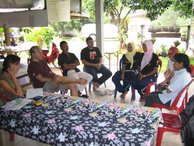
Many of the women lost their husbands in the tsunami but still need to provide food for the family, while others use the revolving fund to earn a little more income. Maybe more importantly it can be used as a source to supplement their income if another disaster happens or the men cannot fish. Many of these people are extremely poor and one more source of income makes all the difference in whether they can buy food to feed their families.
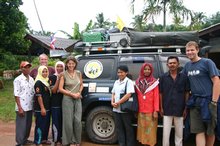 In this village, many fishermen were directly affected by the tsunami and 18 families lost everything - the whole business washed away. Many families were indirectly affected, by not being able to fish for the family�s consumption anymore. We asked if they had seen a positive result from the implementation of the revolving funds, in which they said they are coming to realise that the hard work is an investment rather than an instant gratification. Some things don't change around the world!
In this village, many fishermen were directly affected by the tsunami and 18 families lost everything - the whole business washed away. Many families were indirectly affected, by not being able to fish for the family�s consumption anymore. We asked if they had seen a positive result from the implementation of the revolving funds, in which they said they are coming to realise that the hard work is an investment rather than an instant gratification. Some things don't change around the world!
With the loans securing fee repayments, the villagers want any profits acquired in the revolving fund to go back into the community, so everyone can be helped. There are many poorer people who cannot help themselves, especially the elderly. They want to keep the elderly active, or make sure that there is money available for emergency sick care. A noble action indeed, as none of these people have a lot of money. So far in the short time the revolving fund has been active, 20,000baht (approx 280ukp) profit has accumulated in the fund. 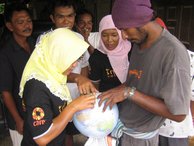
It was a good feeling knowing we�d helped out in a small way. All the money we paid for lunches, dinners, rides on the boats and homestays was directly reinvested back into these new business ventures.
It was really interesting to see the rehabilitation and the adjustment beyond the building of old businesses and extending into new ideas to make positive changes in the community. There is still a lot of learning to be had, but this all takes time and will do so when the people of the community are ready. We asked many questions about the future which still need to be addressed, but with the support of Raks Thai and the willingness of the communities for change and resolve, I look forward to following up with Anchalee for progress reports. Thanks for organising the four days Anchalee, it was an extremely interesting journey.
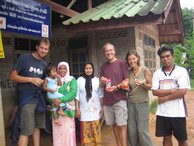 We continued south to Koh Lanta Island, hoping to meet up again with Christian, but unfortunately, business had taken him away so we caught up with Kerstin and Sascha who were holding the fort. We spent a couple of days hanging round, but with the heavy rains making their presence felt we took shelter in one the local chalets and worked on the laptops. I had the luxury of spending half a day in bed reading as the boys wrote diary entries! It came for us to head to our next country and we waved a final goodbye to Thailand and headed South.
We continued south to Koh Lanta Island, hoping to meet up again with Christian, but unfortunately, business had taken him away so we caught up with Kerstin and Sascha who were holding the fort. We spent a couple of days hanging round, but with the heavy rains making their presence felt we took shelter in one the local chalets and worked on the laptops. I had the luxury of spending half a day in bed reading as the boys wrote diary entries! It came for us to head to our next country and we waved a final goodbye to Thailand and headed South.
| All content copyright � overland-underwater.com - please do not use without permission. |
| Comment from Only Gay in the village... |
| No !!! Im the only gay in the village... Your hair looked wonderful Mazley.. |
| 14 Aug 2006 @ 10:54:11 |
